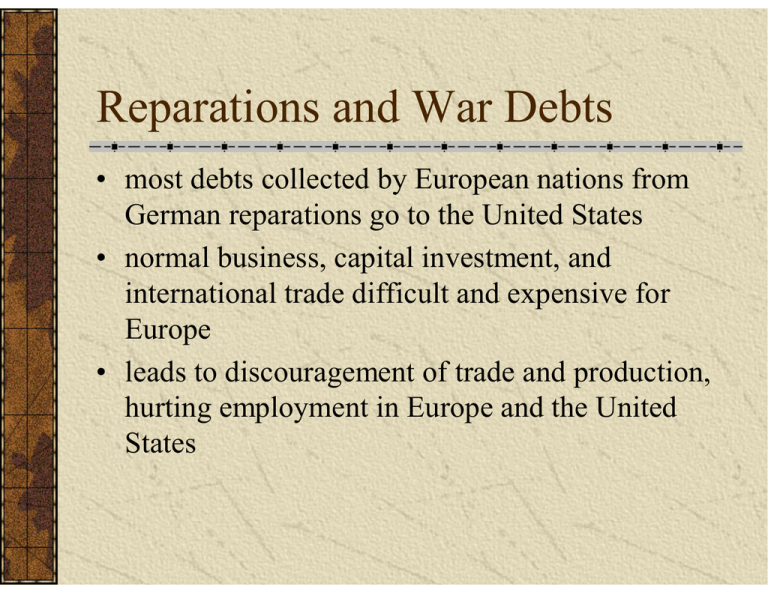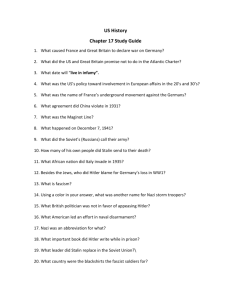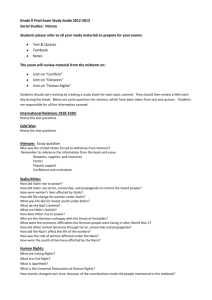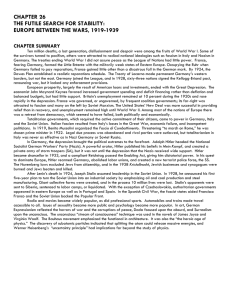Reparations and War Debts
advertisement

Reparations and War Debts • most debts collected by European nations from German reparations go to the United States • normal business, capital investment, and international trade difficult and expensive for Europe • leads to discouragement of trade and production, hurting employment in Europe and the United States Stock Market Crash • Americans take money out of European investments and put them into booming stock market in 1928 • stock market crashes in 1929 as a result of virtually unregulated financial speculation • people cannot pay back loans to banks and many banks collapse • little money invested in Europe The End of Reparations • as German economy worsens, American president Herbert Hoover announces a oneyear moratorium on all payments of international debts • the Lausanne Conference in 1932 effectively ends reparations Problems in the Agriculture • collapse of grain prices mean lower incomes for European farmers • large estates in Eastern Europe broken up for small inefficient farms • people in Asia, South America, and Africa could no longer afford to buy finished good from industrial Europe • commodity production outstripped world demand leading to vast unemployment and an increased depression Government Policies Towards the Depression • Orthodox economic theory felt cuts in government spending would prevent inflation • John Maynard Keynes – urged government spending to expand overall demand • private economic enterprise becomes subject to new trade, labor, and currency regulations Great Britain’s Response to the Great Depression: The National Government • Ramsay MacDonald – headed Labour government, wanted to slash the budget, reduce government salaries, and cut unemployment benefits • National Government – in 1931 takes three steps to end the depression w (1) raised taxes, cut benefits, and lowered government salaries w (2) took Britain off the gold standard w (3) Import Duties Bill – leveled a tariff on all imports, except those from the empire • banking crisis that plagued most of Europe is avoided, but unemployment remains high and the economy remains stagnant France’s Response to the Great Depression: The Popular Front • • depression in France started later and lasted longer due in part to the stoppage of the payment of reparations right-wing violence w groups such as the Action Francaise and Croix de Feu resemble the Nazis in their opposition to parliamentary government, socialism and communism w large demonstration of right wingers leads to the death of fourteen demonstrators in Paris in 1934 • • socialist – communist cooperation – the Popular Front – a coalition of left-wing parties takes over the government Leon Blum - Popular Front’s elected leader w calls for massive labor reforms involving wages, working hours, recognition of unions and the establishment of a National Wheat Board, that managed the sale of grain w French bankers and businessmen outraged • Popular Front dissolves in 1938, leaving France divided and faith lost in the republic Germany: Depression and the Rise of the Nazis • unemployment reaches six million in 1932 • parliamentary deadlock between Social Democrats and conservatives leads to the uprising of extreme political parties (Communists and Nazis) • Nazi politics meant power and intimidation of the Social Democrats and Communists Hitler Comes to Power • President von Hindenburg – after eight months of trying to appease the Nazis without putting Adolf Hitler in power, in January 1933, he names Hitler chancellor • von Hindenburg appointed several Conservatives to the cabinet including Franz von Papen as a way to attempt to control Hitler How Hitler Came to Power • blunders of conservative German politicians who hated the Weimer Republic put Hitler in charge • Hitler mastered techniques of mass politics and propaganda • support came, not just from lower classes, but war veterans, farmers and the young (particularly hurt by the depression) • technically, Hitler came to power through legal means Hitler’s Consolidation of Power • Reichstag Fire – mentally ill communist burns down Reichstag as a result Hitler issues Article 48 – emergency decree suspending civil liberties and arresting suspected Communists • The Enabling Act – permitted Hitler to rule by decree, giving him unlimited power • 1933 – National Socialists the only legal party in Germany • Internal Nazi Party Purges – Hitler orders German army to kill SA or storm troopers including leader Ernst Roehm because they were becoming too popular • Hindenburg dies – Hitler names himself chancellor and president making him sole ruler of Germany and Nazi Party Anti-Semitism and the Police State • SS organization – commanded by Heinrich Himmler, became chief vehicle of police surveillance and carried out the purges • attack on Jewish economic life – anti-Semitism based on biological racial theories, leads to Nazis excluding Jews from civil service and the boycotts of Jewish businesses and shops • Nuremberg Laws – German Jews robbed of citizenship, prohibited from marrying non-Jews, and publicly humiliated • Kristallnacht – Jews forbade to be in business, thousands of Jewish stores and synagogues destroyed and Jews forced to pay for the clean-up • The Final Solution – Jews forced into small ghettos, then taken to prison camps and in 1941 and 1942 the Final Solution leads to the extermination of six million eastern European Jews Women in Nazi Germany • women were expected to breed strong sons and daughters to make a pure race of Germans • Jewish, Slavic, and Gypsy women were killed • women who bore weak children were sterilized, killed or forced to have abortions • motherhood emphasized, but women were encouraged to work especially as educators teaching the young about Nazi philosophy Nazi Economic Policy • Hitler’s oppressive regime received support because he swiftly ended the Depression in Germany • people would sacrifice all political and civil liberty, limit private exercise of capital in order to prepare for war and aggression • massive public works programs • renunciation of the Treaty of Versailles leads Hitler to appoint Hermann Goring, to undertake a four-year plan to prepare the army and economy for war • trade unions crushed and outlawed Italy: Fascism and the Economy • Fascist leader Benito Mussolini attempted to nationalize the wheat industry – the Great Depression affected Italy anyways • corporatism – planned economy linked to the private ownership of capital and to government arbitration of labor disputes w industry first organized into syndicates – two groups would negotiate labor settlements, one from labor and one from management w corporations – grouped together industries relating to a major area of production • production not increased, but bureaucracy and corruption increase • to support going to war, government requires citizens to buy government bonds Russia: Rapid Industrialization • the slowing down of economic production, leads Soviet Communist leader Joseph Stalin to abandon Lenin’s New Economic Policy (NEP) and reject free market operations • series of Five-Year Plans would rapidly increase government run heavy industries • The State Planning Commission or Gosplan oversaw every aspect the economy • economy grows 400% between 1928 and 1940, but at the cost of deplorable human conditions for the workers Collectivization • Stalin forces Russian peasants to give up their private farms and work collectively on farms owned by the state – collectives • Stalin felt this policy would end the hoarding of grain and produce enough domestic food and for foreign export • “dekulakization” – the removal of any peasants, especially those who were well off, who resisted collectivization • millions of peasants are killed, imprisoned, exiled to Siberia or starve to death • religious leaders of many faiths are attacked and their places of worship closed • by 1937, 90% of the country’s grain is collectivized Flight to the Soviet Cities • between 1928 and 1932, twelve million peasants leave the countryside for the city • many women and elderly left behind in impoverished villages Consumer Shortages in the Russian Cities • shortages of the basics – housing, food, and clothing • cities lacked proper transportation, sewer systems, paved streets and lighting • crime and disease widespread Stalin Versus Fascism • allowed communist and non-communist parties to work together to combat Nazis and other fascists • supported Popular Front in France The Purges • Stalin, starting in 1933, gets rid of his enemies and opponents, both real and imagined in the Great Purges • the assassination of party chief Sergei Kirov leads to the first purges w Kirov’s death still a mystery w Killed either by party opponents or perhaps by Stalin himself • Ex-high Soviet leader Bukharin along with other members of the Politburo are executed • millions of people (family members of government leaders, ordinary Soviet citizens, members of the military) are either executed or sent to labor camps • Stalin’s thirst for power and his paranoia caused the purges • Communist Party moves away from the philosophies of Lenin and other early Communist leaders







